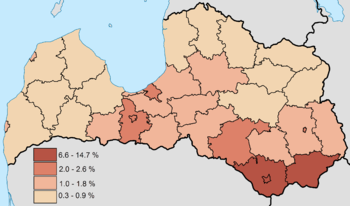
Demographic features of the population of the historical territory of Latvia include population density, ethnic background, education level, health of the populace, economic status, religious affiliations and other aspects of the population.

Viļāni is a town in Rēzekne Municipality in the Latgale region of Latvia. The railway line Riga-Moscow, and the motor highway Riga-Moscow, and the road Preiļi-Balvi cross Viļāni. The Malta river flows through the town. The population in 2020 was 2,813.

Poles, or Polish people, are a West Slavic ethnic group and nation who share a common history, culture, the Polish language and are identified with the country of Poland in Central Europe. The preamble to the Constitution of the Republic of Poland defines the Polish nation as comprising all the citizens of Poland, regardless of heritage or ethnicity. The majority of Poles adhere to Roman Catholicism.
Tutejszy was a self-identification of Eastern European rural populations, who did not have a clear national identity. The term means "from here", "local" or "natives". This was mostly in mixed-lingual Eastern European areas, including Poland, Ukraine, Belarus, Lithuania, and Latvia, in particular, in Polesia and Podlachia. As a self-identification, it persisted in Lithuania’s Vilnius Region into the late 20th century. For example, in 1989, a poll of persons whose passports recorded their ethnicity as Polish revealed that 4% of them regarded themselves as tuteišiai, 10% as Lithuanians, and 84% as Poles.
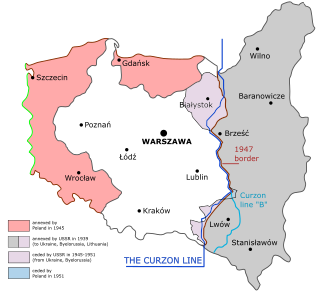
Eastern Borderlands or simply Borderlands was a term coined for the eastern part of the Second Polish Republic during the interwar period (1918–1939). Largely agricultural and extensively multi-ethnic, it amounted to nearly half of the territory of pre-war Poland. Historically situated in the eastern Polish–Lithuanian Commonwealth, following the 18th-century foreign partitions it was divided between the Russian Empire and the Austro-Hungarian Empire, and ceded to Poland in 1921 after the Peace of Riga. As a result of the post-World War II border changes, all of the territory was ceded to the USSR, and none of it is in modern Poland.

The Polish diaspora comprises Poles and people of Polish heritage or origin who live outside Poland. The Polish diaspora is also known in modern Polish as Polonia, the name for Poland in Latin and many Romance languages.

Poland does not legally recognize same-sex unions, either in the form of marriage or civil unions. In 2012, the Supreme Court ruled that same-sex couples have limited legal rights in regards to the tenancy of a shared household. A few laws also guarantee certain limited rights for unmarried couples, including couples of the same sex. Same-sex spouses also have access to residency rights under EU law.
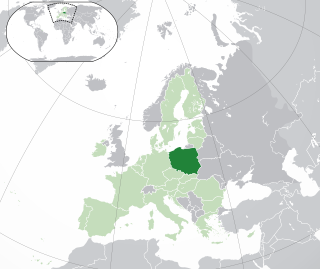
Lesbian, gay, bisexual, and transgender (LGBT) people in Poland face legal challenges not faced by non-LGBT residents. According to ILGA-Europe's 2023 report, the status of LGBTQ rights in Poland is the worst among European Union countries.

Western Belorussia or Western Belarus is a historical region of modern-day Belarus which belonged to the Second Polish Republic during the interwar period. For twenty years before the 1939 invasion of Poland, it was the northern part of the Polish Kresy macroregion. Following the end of World War II in Europe, most of Western Belorussia was ceded to the Soviet Union by the Allies, while some of it, including Białystok, was given to the Polish People's Republic. Until the dissolution of the Soviet Union in 1991, Western Belorussia formed the western part of the Byelorussian Soviet Socialist Republic (BSSR). Today, it constitutes the west of modern Belarus.

A sybirak is a person resettled to Siberia. Like its Russian counterpart sibiryák the word can refer to any dweller of Siberia, but it more specifically refers to Poles imprisoned or exiled to Siberia or even to those sent to the Russian Arctic or to Kazakhstan in the 1940s.

The Polish minority in the Czech Republic is a Polish national minority living mainly in the Trans-Olza region of western Cieszyn Silesia. The Polish community is the only national minority in the Czech Republic that is linked to a specific geographical area. Trans-Olza is located in the north-eastern part of the country. It comprises Karviná District and the eastern part of Frýdek-Místek District. Many Poles living in other regions of the Czech Republic have roots in Trans-Olza as well.

The Poles in Lithuania, also called Lithuanian Poles, estimated at 183,000 people in the Lithuanian census of 2021 or 6.5% of Lithuania's total population, are the country's largest ethnic minority.
Union of Poles in Lithuania is an organization formed in 1989 to bring together members of Polish minority in Lithuania. It numbers between 6,000 to 11,000 members. It defends the civil rights of the Polish minority and engages in educational, cultural and economic activities. It is the largest Polish organization in Lithuania, and was created in 1990.

The Polish minority in Belarus numbers officially 288,000 according to 2019 census. However, according to the Ministry of Foreign Affairs of Poland the number is as high as 1,100,000. It forms the second largest ethnic minority in the country after the Russians, at around 3.1% of the total population. An estimated 205,200 Belarusian Poles live in large agglomerations and 82,493 in smaller settlements, with the number of women exceeding the number of men by 33,905. Some estimates by Polish non-governmental sources in the U.S. are higher, citing the previous poll held in 1989 under the Soviet authorities with 413,000 Poles recorded.
Polish Argentines are Argentine citizens of full or partial Polish ancestry or Poland-born people who reside in Argentina. Poland was the fourth largest net migrants contributor after Italy, Spain and Germany. Although it is hard to give an exact number of Polish immigrants to Argentina, as those who immigrated before 1919 carried German, Austrian or Russian passports, it is estimated that between 1921 and 1976, 169,335 Poles permanently settled in the country. Today there are 500,000 Argentines of Polish descent. The Polish minority in Argentina is both one of the most significant minorities in Argentina and one of the largest groups of Polish minority.
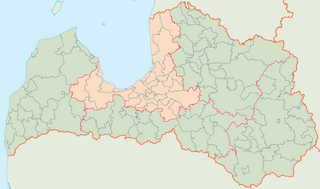
Riga Region, officially Riga Planning Region and shortened as RPR is one of five planning regions of Latvia, situated in the central part of Latvia, in and around the metropolis of Riga and along the shores of the Gulf of Riga. The state institution was founded on 12 October 2006, based on the creation of the region territory as prescribed by Regulations No. 133 of the Cabinet of Ministers as of 25 March 2003, the "Regulations on Territories of Planning Regions".

Around 6 million Polish citizens perished during World War II: about one fifth of the pre-war population. Most were civilian victims of the war crimes and crimes against humanity during the occupation by Nazi Germany and the Soviet Union. Approximately half were Polish Jews killed in The Holocaust. Statistics for Polish World War II casualties are divergent and contradictory. This article provides a summarization of these estimates of Poland's human losses in the war and their causes.
Polish settlement in the Philippines began during the Spanish colonial period, mostly with the arrival of Catholic clergy destined for missionary work in other Asian countries. As of 2010 the 2010 census, there are 93 persons in the Philippines who claim Polish citizenship, and the Polish community in the Philippines is the fourth-largest Central European community in the country, after the local communities of Germans, Hungarians and Albanians.

Poles in Norway are citizens and residents of Norway who are of Polish descent. They are the biggest immigrant group in Norway.
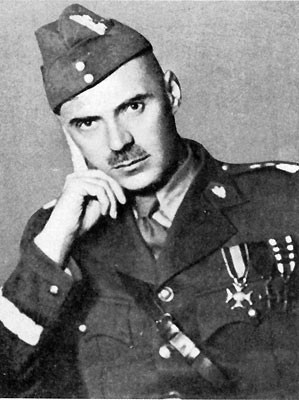
In Polish culture, the True Pole is a stereotype of an ideal Polish person. This stereotype is closely associated with Polish Catholicism. The "true Pole" expression is often invoked in Polish right-wing and nationalist rhetoric.

